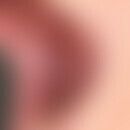HistoryThis section has been translated automatically.
Imamura, 1971
DefinitionThis section has been translated automatically.
Very rare, almost exclusively in Japan and Korea described, circumscribed retraction of the abdominal and breast skin due to fatty tissue dystrophy in children. Isolated cases also in adults. The entity of the clinical picture is not certain (variant of Morphea?).
You might also be interested in
EtiopathogenesisThis section has been translated automatically.
Unknown. Occurs after mechanical trauma and after surgical interventions, among others. Common occurrence with Morphea is described.
ManifestationThis section has been translated automatically.
Occurring in children. The ratio of boys to girls is 1:2.
LocalizationThis section has been translated automatically.
Abdomen, groin.
ClinicThis section has been translated automatically.
Beginning of changes in the groin (80%) or armpits with erythematous, bluish or purple spots. Over the course of months, development of indurated plaques or extensive atrophy of the skin and subcutaneous tissue in which the subcutaneous venous plexus shimmers through. Centrifugal increase in size over several years. 2/3 of the patients do not report any complaints. 1/3 show little pain, tension or itching in the lesional areas.
HistologyThis section has been translated automatically.
Very different histopathological findings were reported with inflammatory infiltrates in the subcutaneous adipose tissue, adipose tissue necrosis and fibrosis of the adipose tissue.
Differential diagnosisThis section has been translated automatically.
TherapyThis section has been translated automatically.
Not known. Trials with oral and local glucocorticoids and penicillin are ineffective.
Progression/forecastThis section has been translated automatically.
Spontaneous regression and healing possible.
LiteratureThis section has been translated automatically.
- Aoki E, Kawana S (2000) Lipodystrophia centrifugalis abdominalis infantilis with ulceration. Dermatology 200: 280-281
- Chang SE et al (2004) Lipodystrophia centrifugalis abdominalis in Korea. Pediatric dermatol 21: 538-541
- Ikoma A et al (1999) A case of lipodystrophia centrifugalis abdominalis infantilis versus morphea. J Dermatol 26: 603-607
- Imamura S et al (1971) Lipodystrophia centrifugalis abdominalis infantilis. Arch Dermatol 104: 291-298
- Imamura S et al (1979) Lipodystophia centrifugalis abdominalis infantilis. dermatologist 30: 360-364
- Kagoura M et al (2001) An ultrastructural study of lipodystrophia centrifugalis abdominalis infantilis, with special reference to fibrous long-spacing collagen. Pediatric Dermatol 18: 13-16
- Tremeau-Martinage C et al (1996) Localized lipatrophia with persistent circulating autoanitbodies and partial immunoglobulin A deficiency in a child. Dermatology 192: 353-357
Outgoing links (4)
Atrophodermia idiopathica et progressiva; Circumscribed scleroderma; Glucocorticosteroids; Lipodystrophy progressive partial;Disclaimer
Please ask your physician for a reliable diagnosis. This website is only meant as a reference.




